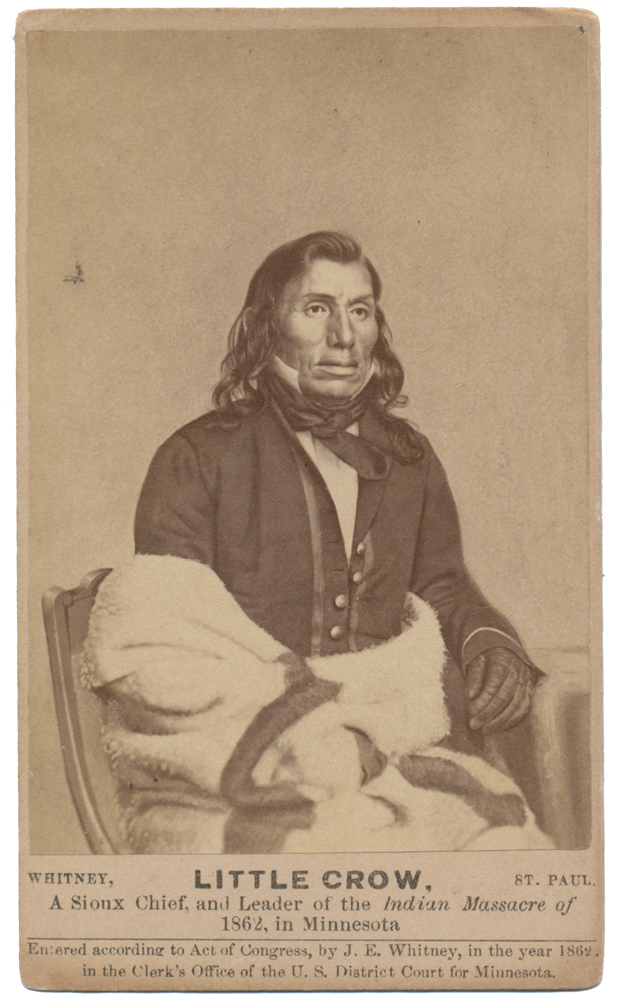site search
online catalog
CDV OF SIOUX INDIAN CHIEF, LITTLE CROW (TAOYATEDUTA)

Hover to zoom
$450.00 SOLD
Quantity Available: None
Item Code: 748-19
Front caption: "Whitney, St. Paul [MN]. A Sioux Chief and Leader of the Indian Massacre of 1862. Image lightly faded, while remaining clear and sharp. Subject in seated pose, in studio setting, exuding considerable dignity, wearing frock coat, wrapped in Indian blanket.
Following the 1862 Uprising which saw the Sioux pushed out of Minnesota and into the Dakotas, 238 were hanged in Mankato, MN, that fall [after President Lincoln had pared the list down from the several hundred that Minnesota settlers had wanted hung.]
Taoyateduta (which translates as "His Scarlet Nation," though he was more often known as Little Crow, after his father) was born into the Mdewakanton village of Kaposia about 1810. He succeeded his father as leader in 1846. During the 1850s, he was widely recognized as a spokesperson for all the Lower bands of Dakota. He was a negotiator and signer of the Treaty of Mendota in 1851 and the Treaty of 1858. By the 1860s, Little Crow had adopted some European customs — he owned some European-styled clothing, for example, and he lived in a wood-frame house. But like most Dakota farmers on the Lower reservation, he staunchly refused to compromise his Dakota religious beliefs.
He led Dakota forces in the US-Dakota War of 1862. Little Crow tried to use his knowledge of white culture to guide the course of the war. On August 19, with hundreds of settlers already dead in Brown and Renville counties, and with attacks on white settlements continuing, he is reported to have said, “Soldiers and young men, you ought not to kill women and children. . . . You should have killed only those who have been robbing us so long. Hereafter make war after the manner of white men."
On September 7, 1862 — three weeks into the fighting — Little Crow sent a letter to Henry Sibley pinpointing the reasons Lower soldiers went to war. Little Crow’s letter condenses decades of frustration over misuse of government funds, late annuity payments, and poor relations between government officials and Dakota leaders into a few terse sentences.
"Dear Sir – For what reason we have commenced this war I will tell you. it is on account of Maj. Galbrait [sic] we made a treaty with the Government a big for what little we do get and then cant get it till our children was dieing with hunger – it is with the traders that commence Mr A[ndrew] J Myrick told the Indians that they would eat grass or their own dung. Then Mr [William] Forbes told the lower Sioux that [they] were not men [,] then [Louis] Robert he was working with his friends how to defraud us of our money, if the young braves have push the white men I have done this myself."
Letter to Col. Sibley, Sept. 12, 1862:
"Red Iron Village or Mazawakan
To Hon H. H. Sibley
We have in Mdewakanton band one hundred & fifty five prisoners. not including the Sisiton [sic] & Warpeton [sic] prisoners. then we are waiting for the Sisiton what we are going to do with the prisoners they are coming down. they are at Lake qui Parl now. the words that I have sent to the governed I want to here [sic.] from him also. and I want to know from you as a friend what way that I can make peace for my people. in regard to prisoners they fair [sic.] with our children or our self just as well as us
your truly friend
Little Crow
per Scott Campbell"
After the Battle of Wood Lake, he left Minnesota and attempted to gather support for a continued war in the west and Canada. He was killed on July 3, 1863 after returning to Minnesota. For many years some of his remains were put on display by the Minnesota Historical Society before being returned to his descendants for burial.
Superb Civil War-Indian War collectible. [jp/ld][ph:L]
~~~~~~~~~~~~~~~~~~~~~~~~~~~~~~~~~~~
THIS ITEM, AS WITH ALL OTHER ITEMS AVAILABLE ON OUR WEB SITE,
MAY BE PURCHASED THROUGH OUR LAYAWAY PROGRAM.
CLICK HERE FOR OUR POLICIES AND TERMS.
THANK YOU!
Inquire About CDV OF SIOUX INDIAN CHIEF, LITTLE CROW (TAOYATEDUTA)
Most Popular
Historical Firearms Stolen From The National Civil War Museum In Harrisburg, Pa »
Theft From Gravesite Of Gen. John Reynolds »
Selection Of Unframed Prints By Don Troiani »
Fine Condition Brass Infantry Bugle Insignia »
Large English Bowie Knife With Sheath 1870’S – 1880’S »
Imported (Clauberg) Us Model 1860 Light Cavalry Officer's Saber »
featured item
LARGE FRAMED RELIC SHOWBOARD
This relic board is very like those assembled from Gettysburg relics by John Rosensteel and displayed on the porch of the Round Top Museum, but differs in displaying the relics on horizontal rather than raw vertical boards, in having a glass frame,… (1242-06). Learn More »


